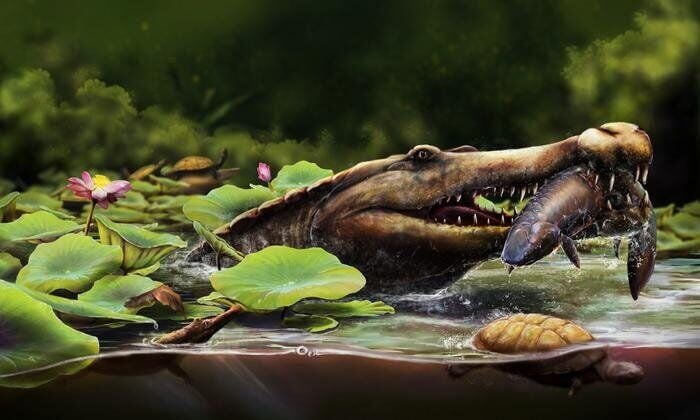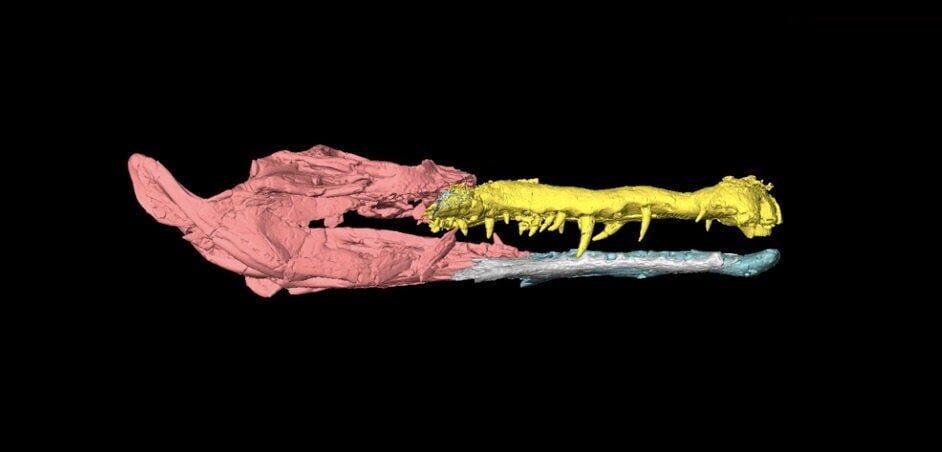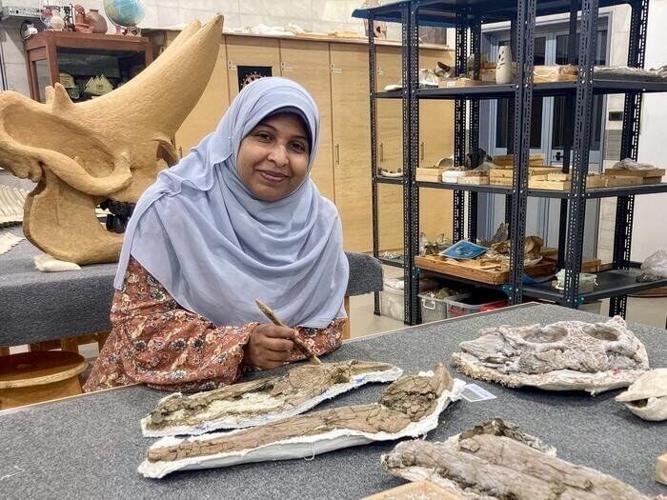
Life reconstruction of Wadisuchus kassabi from the Late Cretaceous of Egypt, showing an adult capturing a lungfish in a wetland, with a juvenile nearby. (Nathan Dehaut via SWNS)
By Stephen Beech
A sharp-toothed fossil found in an Egyptian desert proves that sea-going crocodiles originated in Africa, according to scientists.
They say the earliest long-snouted fossil crocodile, which was around 12 feet long, lived about 80 million years ago.
The species, dubbed Wadisuchus kassabi, has been recognised as the earliest known member of Dyrosauridae - a group of ancient crocs that differed markedly from their modern relatives.
The fossil, discovered in the Egyptian Western Desert, "fundamentally" reshapes understanding of crocodile evolution, according to a study published in The Zoological Journal of the Linnean Society.

3D digital model of the Wadisuchus composite skull generated using CT scanning and 3D surface reconstruction. (Belal Salem and Joseph Georanke via SWNS)
Unlike today’s crocodiles, dyrosaurids thrived in coastal and marine environments, equipped with elongated snouts and slender, needle-sharp teeth ideal for seizing slippery prey such as fish and turtles.
The Egyptian-led research team says their "remarkable" survival and dispersal after the extinction of the dinosaurs make them "crucial" for understanding how reptiles adapted and diversified when global ecosystems collapsed.
They explained that the name Wadisuchus kassabi blends Egypt’s landscape and legacy - Wadi, Arabic for “valley” and Suchus for the ancient crocodile god Sobek.
The species also honours Professor Ahmed Kassab, whose work in Egyptian palaeontology continues to inspire new generations.

Lead author Sara Saber (Assiut University / MUVP), pictured with the holotype specimen of Wadisuchus kassabi (MUVP 180) at the Mansoura University Vertebrate Paleontology Center, Mansoura, Egypt. (Hesham Sallam via SWNS)
Study senior author Professor Hesham Sallam, of Mansoura University, said: “The fossils of Wadisuchus kassabi were excavated near Kharga and Baris oases in Egypt’s Western Desert.
"They include two partial skulls and two snout tips representing four individuals at different stages of growth, providing rare insight into how dyrosaurids developed.
“High-resolution CT scans and 3D surface models enabled us to reveal unprecedented anatomical details."
Lead author Sara Saber, of Assiut University, said: “Wadisuchus kassabi was a 3.5- to four-metre-long crocodile-like reptile with a very long snout and tall, sharp teeth.
"It differed from other dyrosaurids in having four teeth at the front of the snout instead of the primitive five, nostrils positioned on top of the snout for surface breathing, and a deep notch at the tip of the snout where the jaws met.
"These features show a gradual adaptation in the dyrosaurid bite, marking an important step in their evolutionary history."
She added: “Beyond the distinctive features of Wadisuchus, it plays a crucial role in understanding the origin of the dyrosaurid group.

Vish K
The new species pushes back evidence for an African origin of Dyrosauridae and suggests that their diversification began earlier than previously thought -possibly during the Early Coniacian–Santonian, about 87 to 83 million years ago, rather than the traditionally assumed Maastrichtian, about 72 to 66 million years ago."
Belal Salem, a PhD student at Ohio University and a member of the Sallam Lab, said: “This discovery indicates that Africa was the cradle of dyrosaurid evolution, from which later lineages spread across the globe and our phylogenetic analyses consistently place Wadisuchus an ancestor of the dyrosaurid group."
He added: “The significance of Wadisuchus lies not only in what it reveals about the evolutionary history of this remarkable group of crocodiles - though that is a major achievement - but also in what it reminds us of.
"Egypt’s Western Desert still holds treasures that preserve the secrets of our planet’s deep past.
"Our mission is not only to uncover these fossils but also to protect the fossil-rich sites from urban expansion and agricultural encroachment.
"They are a legacy for generations of Egyptians to come.”





















(0) comments
Welcome to the discussion.
Log In
Keep it Clean. Please avoid obscene, vulgar, lewd, racist or sexually-oriented language.
PLEASE TURN OFF YOUR CAPS LOCK.
Don't Threaten. Threats of harming another person will not be tolerated.
Be Truthful. Don't knowingly lie about anyone or anything.
Be Nice. No racism, sexism or any sort of -ism that is degrading to another person.
Be Proactive. Use the 'Report' link on each comment to let us know of abusive posts.
Share with Us. We'd love to hear eyewitness accounts, the history behind an article.